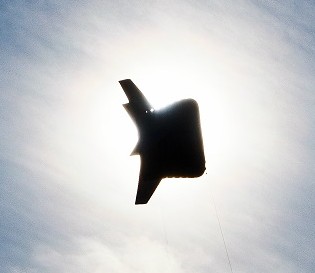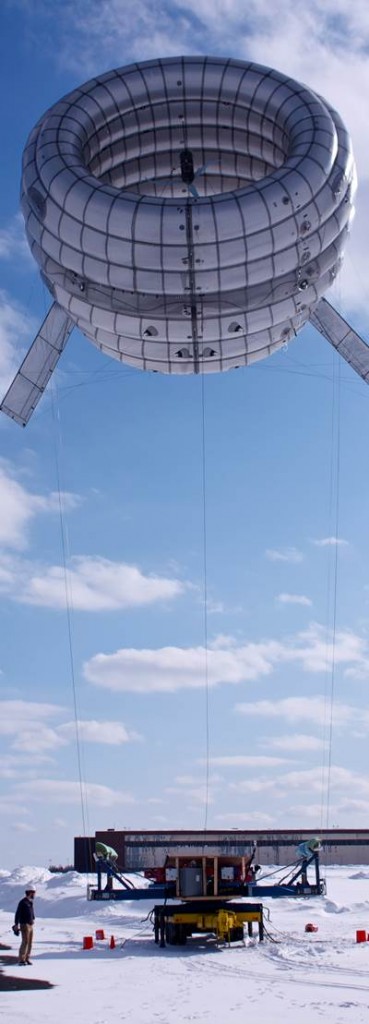March 26, 2014 – A combination balloon and turbine is about to be launched in Alaska by Altaeros Energies in an 18-month trial and at a cost of $1.3 million U.S. Called the BAT, standing for Buoyant Airborne Turbine, it consists of helium-filled fabric shell, a three-blade turbine that nests inside the shell, a high strength tethering system to keep the turbine fixed in place, and a ground station control system.
The design of the shell allows it to automatically align with the prevailing wind. The helium buoyancy ensures it stays aloft even when the winds die. And the shell has additional advantages such as the ability to attach sensors, cameras and communication equipment (at maximum altitude it provides 100 kilometer radius line of sight) so that it can serve multiple purposes.
The turbine is conventional and mounted inside the surrounding shell. The tethers serve both to anchor and transmit the power from the turbine to the ground. The ground station not only anchors the BAT but also conditions the power it receives from the turbine so that it can be connected to a grid or customer.
Where would you deploy a BAT? Largely designed for remote settings the BAT has applications in isolated rural communities such as small islands, polar communities, at mining and rig sites (the latter on land or at sea), and for emergency and military deployment. Have BAT and you have power.
The BAT operates at altitudes of up to 600 meters (approximately 2,000 feet) where it captures the steady winds that ground-based turbines cannot. It can withstand winds up to 160 kilometers (100 miles) per hour. It can take the rain, snow, hail and sleet. It can handle lightning strikes. And should the weather be even more severe it can be lowered and anchored to its ground station and continue to produce power.
Unlike ground-based wind turbines, the BAT is portable and easy to deploy. With no tower, no pouring of a cement foundation, no tricky installation of the turbine and blades, setup and operational costs are significantly lower than conventional wind turbine technology.
If the BAT’s shell is punctured or if a tether breaks loose the technology is designed to safely descend. Once deployed it can be remotely managed through its ground station with no human crew present.
In its Alaska deployment the BAT will transmit enough electricity to power a dozen or more homes. The current cost of generating electricity from wind farms runs at around $0.04 per kilowatt hour. The BAT’s cost is 4.5 times that but for the types of deployment Altaeros envisions for it, that extra power cost makes its deployment viable.
Altaeros Energies, founded in 2010, is Boston-based and a startup launched from research done at the Massachusetts Institute of Technology.














[…] New Alaska Wind Turbine Literally Up in the Air https://www.21stcentech.com/energy-update-alaska-wind-turbine-literally-air/ […]